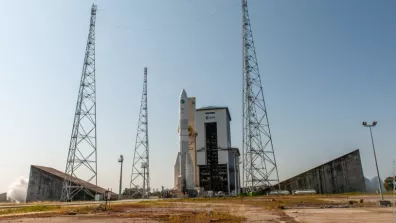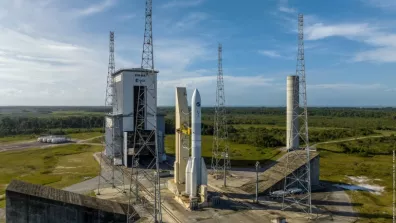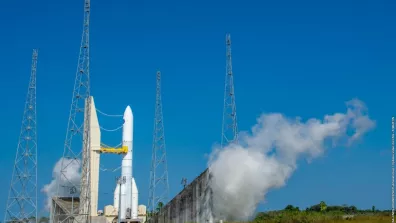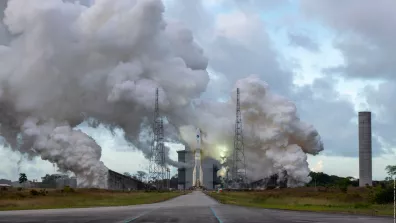The Ariane 6 Launcher Task Force consists of top management of ESA, as the overall Ariane 6 procuring entity and launch system architect, of the French space agency CNES, as the launch base prime contractor, of ArianeGroup as the launcher system prime contractor and of Arianespace as the launch service provider. This group reports regularly on progress being made towards inaugural flight of the new Ariane 6 launcher.
Key milestones towards inaugural flight
On the way towards the inaugural flight of Ariane 6 two important tests have already been implemented.
- On 18 July the hot firing test of the main stage with the Vulcain 2.1 engine ignition in Kourou was successful, completing for the first time the launcher preparation and countdown sequence.
- On 1 September the upper stage hot firing test in Lampoldshausen was also a success, representing the full operational phase during Ariane 6’s first flight.
During the preparatory operations for the next test, the long-duration firing test, initially planned on 3 October in Kourou, an anomaly has been detected on the core stage’s hydraulic group. This equipment made by SABCA (Belgium) is part of the Thrust Vector Control (TVC) system of the core stage. The role of the TVC system is to maintain the launcher's correct attitude by gimballing the Vulcain 2.1 engine during its operation. Activation of the TVC is part of the long duration firing test.
A group of experts has been tasked to analyse and propose solutions to resolve the anomaly, characterised by an abnormal internal pressure of the hydraulic group. Because of the time needed by the experts to disassemble the equipment, assess the problem and determine the root cause, the schedule for Ariane 6 launch rehearsals has been adapted. In order to optimise the schedule, the test sequence has been inverted leading to the anticipation of the launch rehearsal test under different environmental conditions followed by the long-duration firing test of the main stage Vulcain 2.1 engine.
The modification of the test sequence allows the Ariane 6 teams to keep the pace on the progressive achievement of qualification objectives and to reduce any impact on the schedule.
Next milestones
October 2023: Combined test, launch rehearsal with ignition of the main stage, Kourou, French Guiana
As part of the test sequence reconfiguration, the Ariane 6 Task force decided to bring forward to end of October a rehearsal test originally planned to be held after the long firing test.
This full-scale 36-hour long test is compatible with the parallel resolution of the anomaly on the hydraulic group. It consists in the execution of a full launch chronology enriched by qualification tests on several launch system functions including ventilation of cavities, launch range interfaces, and environmental characterisation. This time, operations will be executed during the coolest hours of the day at dawn time.
The test results will be part of the Ariane 6 qualification.
November 2023: Combined test, long-duration firing of the main stage with Vulcain 2.1 engine, Kourou, French Guiana.
Similar to the previous hot-firing rehearsals, this test will end with a full eight minutes (470 seconds) of firing of the Vulcain 2.1 engine, representing the entire flight phase of the core stage.
The anomaly affecting the hydraulic group of the TVC system resulted in a change of the test schedule. ArianeGroup as prime contractor and SABCA as supplier already prepared a replacement specimen of the hydraulic group, without waiting for the results of the technical investigation. Once the equipment is integrated on the Ariane 6 launcher specimen, teams will finish preparations for the test which is now planned on 23 November.
As per standing plan, the Ariane 6 first flight launch period estimate will only be given when the combined long firing test will have been carried out and the test results are analysed.
December 2023: Upper stage firing test, Lampoldshausen, Germany
It is planned to examine stage behaviour in degraded cases.
The adaptation of the test sequence keeps the Ariane 6 development on track for a launch in 2024.
Ariane 6 is an all-new design, created to succeed Ariane 5 as Europe's heavy-lift launch system. With Ariane 6's upper stage restart capability, Europe's launch capability will be tailored to the needs of multiple payload missions, for example to orbit satellite constellations. This autonomous capability to reach Earth orbit and deep space supports Europe's navigation, Earth observation, scientific and security programmes. Ongoing development of Europe's space transportation capabilities is made possible by the sustained dedication of thousands of talented people working in ESA's 22 Member States.





